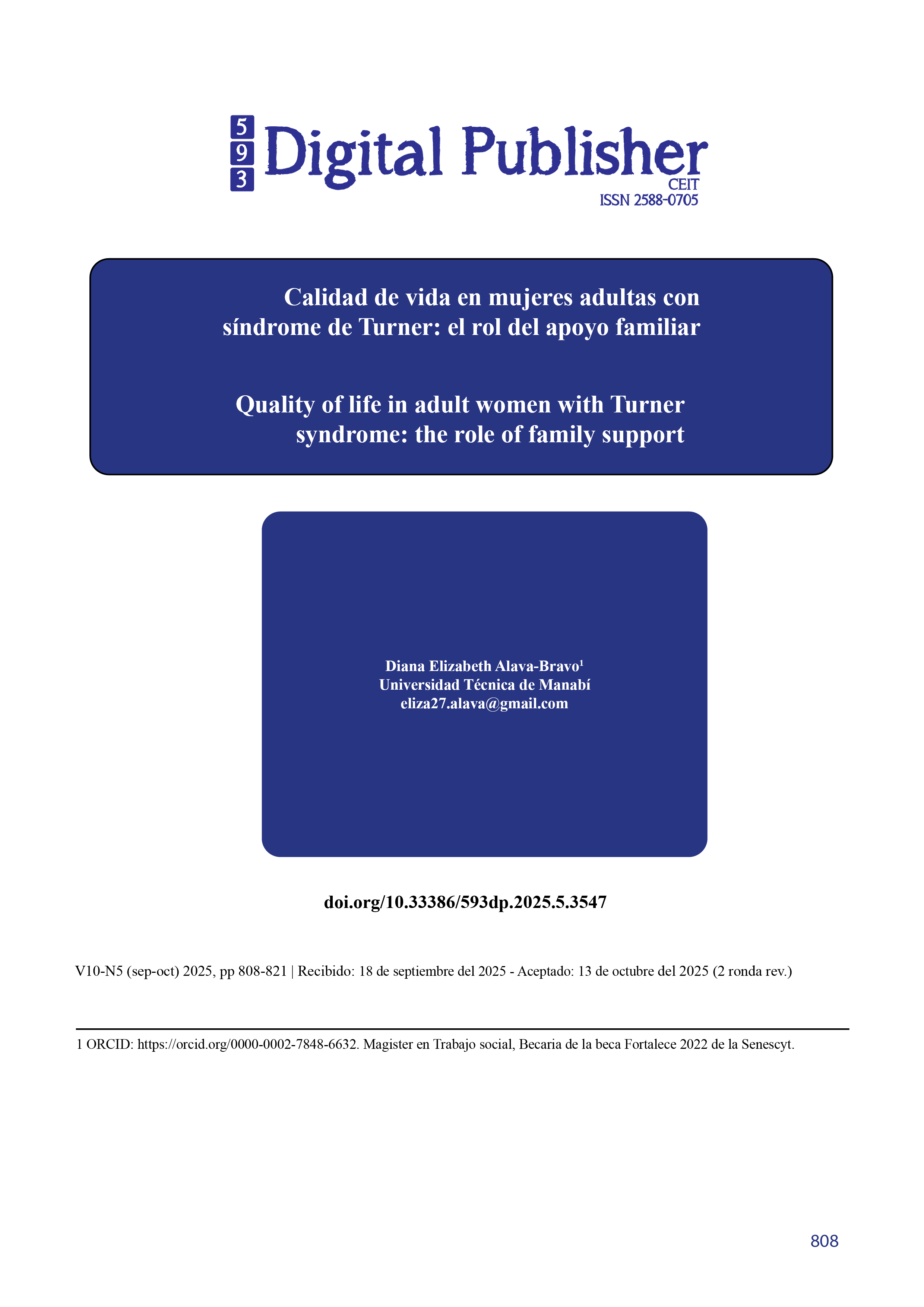Calidad de vida en mujeres adultas con síndrome de Turner: el rol del apoyo familiar
Contenido principal del artículo
Resumen
Este estudio cualitativo descriptivo analizó cómo el apoyo familiar incide en la calidad de vida de mujeres adultas con síndrome de Turner en Ecuador, para lo cual se aplicaron entrevistas estructuradas a seis participantes (≥20 años) vinculadas a la Fundación Ecuatoriana Para la Ayuda del Síndrome de Turner (FEPAST) mediante muestreo no probabilístico por conveniencia, y las transcripciones se sometieron a análisis temático; en este marco, los hallazgos indican que el apoyo familiar, especialmente en sus componentes emocional e instrumental y también en el económico, fortalece la autoestima, facilita la adherencia a controles y tratamientos y ofrece contención durante episodios de dolor o malestar, mientras que la comunicación abierta posibilita expresar necesidades y atenúa el impacto psicosocial del síndrome sobre la autoimagen y la participación social. No obstante, persisten tensiones ligadas a comparaciones sociales y a la carga clínica crónica, de modo que el apoyo opera como recurso protector que, sin eliminar todas las dificultades, mejora la percepción de bienestar y la organización de la vida cotidiana; en consecuencia, se recomienda fortalecer intervenciones de trabajo social en salud orientadas a la psicoeducación familiar y al entramado de redes de apoyo, así como ampliar futuras investigaciones con diseños mixtos y muestras mayores a fin de estimar efectos comparativos con mayor precisión.
Descargas
Detalles del artículo

Esta obra está bajo una licencia internacional Creative Commons Atribución-NoComercial-CompartirIgual 4.0.
1. Derechos de autor
Las obras que se publican en 593 Digital Publisher CEIT están sujetas a los siguientes términos:
1.1. 593 Digital Publisher CEIT, conserva los derechos patrimoniales (copyright) de las obras publicadas, favorece y permite la reutilización de las mismas bajo la licencia Licencia Creative Commons 4.0 de Reconocimiento-NoComercial-CompartirIgual 4.0, por lo cual se pueden copiar, usar, difundir, transmitir y exponer públicamente, siempre que:
1.1.a. Se cite la autoría y fuente original de su publicación (revista, editorial, URL).
1.1.b. No se usen para fines comerciales u onerosos.
1.1.c. Se mencione la existencia y especificaciones de esta licencia de uso.
Citas
Ambrose-Miller, W., & Ashcroft, R. (2016). Challenges faced by social workers as members of interprofessional collaborative health care teams. Health & Social Work, 41(2), 101–109. https://doi.org/10.1093/hsw/hlw006.
Bondy, C. A. (2007). Care of girls and women with Turner syndrome: A guideline of the Turner Syndrome Study Group. Journal of Clinical Endocrinology & Metabolism, 92(1), 10–25. https://doi.org/10.1210/jc.2006-1374
Carel, J., Ecosse, E., Bastie-Sigeac, I., Cabrol, S., Tauber, M., Léger, J., Nicolino, M., Brauner, R., Chaussain, J., & Coste, J. (2005). Quality of life determinants in young women with Turner’s syndrome after growth hormone treatment: Results of the StaTur population-based cohort study. Journal of Clinical Endocrinology & Metabolism, 90(4), 1992–1997. https://doi.org/10.1210/jc.2004-1395
Chartrand, J., Shea, B., Hutton, B., Dingwall, O., Kakkar, A., Chartrand, M., Poulin, A., & Backman, C. (2023). Patient- and family-centred care transition interventions for adults: A systematic review and meta-analysis of RCTs. International Journal for Quality in Health Care, 35(4), mzad102. https://doi.org/10.1093/intqhc/mzad102
Cohen, S., & Wills, T. A. (1985). Stress, social support, and the buffering hypothesis. Psychological Bulletin, 98(2), 310–357. https://doi.org/10.1037/0033-2909.98.2.310.
Culen, C., Ertl, D.-A., Schubert, K., Bartha-Doering, L., & Haeusler, G. (2017). Care of girls and women with Turner syndrome: Beyond growth and hormones. Endocrine Connections, 6(4), R39–R51. https://doi.org/10.1530/EC-17-0036
Davis, S. M., & Geffner, M. E. (2019). Cardiometabolic health in Turner syndrome. Journal of the American Heart Association, 8(10), e011501. https://doi.org/10.1161/JAHA.118.011501
De Saxe Zerden, L., Lombardi, B. M., & Jones, A. (2019). Social workers in integrated health care: Improving care throughout the life course. Social Work in Health Care, 58(1), 142–149. https://doi.org/10.1080/00981389.2019.1553934.
DiMatteo, M. R. (2004). Social support and patient adherence to medical treatment: A meta-analysis. Health Psychology, 23(2), 207–218. https://doi.org/10.1037/0278-6133.23.2.207.
Donadille, B., & Christin-Maitre, S. (2021). Heart and Turner syndrome. Annales d’Endocrinologie (Paris), 82(3–4), 135–140. https://doi.org/10.1016/j.ando.2020.12.004
Duijnhouwer, A. L., Bons, L. R., Timmers, H. J. L. M., Snoeren, M., Timmermans, J., Kempers, M., Fleischer, K., & Roos-Hesselink, J. (2019). Aortic dilatation and outcome in women with Turner syndrome. Heart, 105(9), 693–700. https://doi.org/10.1136/heartjnl-2018-313716
Ertl, D.-A., Gleiss, A., Schubert, K., Bartha-Doering, L., Haeusler, G., & Culen, C. (2018). Health status, quality of life and medical care in adult women with Turner syndrome. Endocrine Connections, 7(4), 534–543. https://doi.org/10.1530/EC-18-0053
EuroQol Group. (1990). EuroQol—A new facility for the measurement of health-related quality of life. Health Policy, 16(3), 199–208. https://doi.org/10.1016/0168-8510(90)90421-9.
Ferrans, C. E., Zerwic, J. J., Wilbur, J., & Larson, J. L. (2005). Conceptual model of health-related quality of life. Journal of Nursing Scholarship, 37(4), 336–342. https://doi.org/10.1111/j.1547-5069.2005.00058.x.
Fonseca, K. (2022). Proceso de socialización primaria en tres mujeres diagnosticadas con Síndrome Turner vinculadas a la Fundación Corazón Síndrome Turner Colombia [Tesis de Maestría, Universidad Nacional de Colombia] Repositorio institucional. https://repositorio.unal.edu.co/handle/unal/85241
González-Vega, A., Molina, R., López, A., y López, G. (2022). La entrevista cualitativa como técnica de investigación en el estudio de las organizaciones. New Trends in Qualitative Research, 14, e571. https://doi.org/10.36367/ntqr.14.2022.e571
Gravholt, C. H., Andersen, N. H., Conway, G. S., Christin-Maitre, S., Duijnhouwer, A., Gawlik, A., Maciel-Guerra, A., Gutmark-little, I.,Fleischer, K., Hong, D., O Klein, K., Prakash, S., Shankar, R., Sandberdg, D., Sas, T., Stochholm, K. & Sandberg, D . (2024). Clinical practice guidelines for the care of girls and women with Turner syndrome (2024 update). European Journal of Endocrinology, 190(6), G53–G166. https://doi.org/10.1093/ejendo/ggae043
Guevara, G., Verdesoto, A., y Castro, N. (2020). Metodologías de investigación educativa (descriptivas, experimentales, participativas y de investigación-acción). Revista Científica Mundo de la Investigación y el Conocimiento, 4(3), 163–173. https://doi.org/10.26820/recimundo/4.(3).julio.2020.163-173
Guzmán, V. (2021). El método cualitativo y su aporte a la investigación en las ciencias sociales. Gestionar: Revista de Empresa y Gobierno, 1(4), 19–31. https://doi.org/10.35622/j.rg.2021.04.002
Hernández, O. (2021). Aproximación a los distintos tipos de muestreo no probabilístico que existen. Revista Cubana de Medicina General Integral, 37(3), 1–3. http://scielo.sld.cu/scielo.php?script=sci_arttext&pid=S0864-21252021000300002
Huang, A. C., Olson, S. B., & Maslen, C. L. (2021). A review of recent developments in Turner syndrome research. Journal of Cardiovascular Development and Disease, 8(11), 138. https://doi.org/10.3390/jcdd8110138
Joo, Y., Jang, Y., & Oh, Y. (2024). Contents and effectiveness of patient- and family-centred care interventions in adult intensive care units: A systematic review. Nursing in Critical Care. https://doi.org/10.1111/nicc.13105
Karimi, M., & Brazier, J. (2016). Health, health-related quality of life, and quality of life: What is the difference? PharmacoEconomics, 34(7), 645–649. https://doi.org/10.1007/s40273-016-0389-9.
López, W. (2017). Revisión bibliográfica actualizada del síndrome Turner [Tesis de grado, Universidad de Ciencias Aplicadas y Ambientales]. Repositorio Institucional U.D.C.A. https://repository.udca.edu.co/handle/11158/850
Mann, L., & VanLooy, L. (2024). The impact of amplification on quality of life in women with Turner syndrome. Orphanet Journal of Rare Diseases, 19, 119. https://doi.org/10.1186/s13023-024-03122-z
Martire, L. M., & Helgeson, V. S. (2017). Close relationships and the management of chronic illness: Associations and interventions. American Psychologist, 72(6), 601–612. https://doi.org/10.1037/amp0000066
Noel, L., Chen, Q., Petruzzi, L. J., Phillips, F., Garay, R., Valdez, C., Aranda, M. P., & Jones, B. (2022). Interprofessional collaboration between social workers and community health workers to address health and mental health in the United States: A systematised review. Health & Social Care in the Community, 30(6), e6240–e6254. https://doi.org/10.1111/hsc.14061.
Reblin, M., & Uchino, B. N. (2008). Social and emotional support and its implication for health. Current Opinion in Psychiatry, 21(2), 201–205. https://doi.org/10.1097/YCO.0b013e3282f3ad89.
Reeve, B. B., Wyrwich, K. W., Wu, A. W., Velikova, G., Terwee, C. B., & Snyder, C. F. (2013). ISOQOL recommends minimum standards for patient-reported outcome measures used in patient-centered outcomes and comparative effectiveness research. Quality of Life Research, 22(8), 1889–1905. https://doi.org/10.1007/s11136-012-0344-y.
Reimann, G. E., Perman, M. M. B., Ho, P.-S., Parks, A. R., & Comis, L. E. (2018). Psychosocial characteristics of women with a delayed diagnosis of Turner syndrome. The Journal of Pediatrics, 199, 206–211. https://doi.org/10.1016/j.jpeds.2018.03.058
Salazar-Escorcia, L. (2020). Investigación cualitativa: Una respuesta a las investigaciones sociales educativas. Revista Interdisciplinaria de Humanidades, Educación, Ciencia y Tecnología, 6(11), 101–110. https://doi.org/10.35381/cm.v6i11.327
Sartori, M., Urquijo, S., López, M., Said, A., y Alchier, J. (2015). Análisis de perfiles de personalidad en mujeres adultas con diagnóstico de síndrome de Turner. Interdisciplinaria, 32(1), 73–87. https://www.redalyc.org/articulo.oa?id=18041090004
Silberbach, M., Roos-Hesselink, J. W., Andersen, N. H., Btown, N., Collins, T., & De Backer, J. (2018). Cardiovascular Health in Turner Syndrome: A Scientific Statement From the American Heart Association. Circulation: Genomic and Precision Medicine, 11(10), e000048. https://doi.org/10.1161/HCG.0000000000000048
Stochholm, K., Juul, S., Juel, K., Naeraa, R. W., & Gravholt, C. H. (2006). Prevalence, incidence, diagnostic delay, and mortality in Turner syndrome. Journal of Clinical Endocrinology & Metabolism, 91(10), 3897–3902. https://doi.org/10.1210/jc.2006-0558
Testa, M. A., & Simonson, D. C. (1996). Assessment of quality-of-life outcomes. The New England Journal of Medicine, 334(13), 835–840. https://doi.org/10.1056/NEJM199603283341306.
The WHOQOL Group. (1995). The World Health Organization quality of life assessment (WHOQOL): Position paper from the World Health Organization. Social Science & Medicine, 41(10), 1403–1409. https://doi.org/10.1016/0277-9536(95)00112-K.
The WHOQOL Group. (1998). Development of the World Health Organization WHOQOL-BREF quality of life assessment. Psychological Medicine, 28(3), 551–558. https://doi.org/10.1017/S0033291798006667.
Uchino, B. N. (2009). Understanding the links between social support and physical health: A life-span perspective with emphasis on the separability of perceived and received support. Perspectives on Psychological Science, 4(3), 236–255. https://doi.org/10.1111/j.1745-6924.2009.01122.x.
Van den Hoven, A. T., Bons, L. R., Dykgraaf, R. H. M., Dessens, A. B., Pastoor, H., de Graaff, L. C. G., Metselaar, R. M., Kneppers-Swets, A., Kardys, I., Mijnarends, H., Zweerus, F., Hazelzet, J. A., Utens, E. M. W. J., van den Bosch, A. E., & Roos-Hesselink, J. W. (2020). A value-based healthcare approach: Health-related quality of life and psychosocial functioning in women with Turner syndrome. Clinical Endocrinology, 92(5), 434–442. https://doi.org/10.1111/cen.14166.
Ware, J. E., Jr., & Sherbourne, C. D. (1992). The MOS 36-Item Short-Form Health Survey (SF-36): I. Conceptual framework and item selection. Medical Care, 30(6), 473–483. https://doi.org/10.1097/00005650-199206000-00002.
Wilson, I. B., & Cleary, P. D. (1995). Linking clinical variables with health-related quality of life: A conceptual model of patient outcomes. JAMA, 273(1), 59–65. https://doi.org/10.1001/jama.1995.03520250075037.


